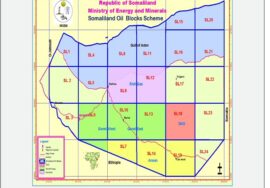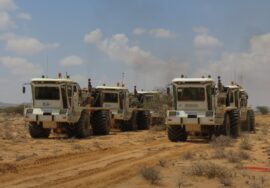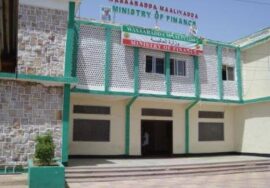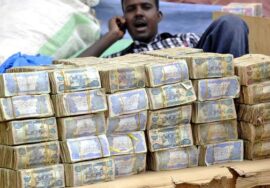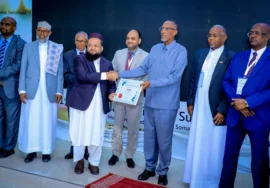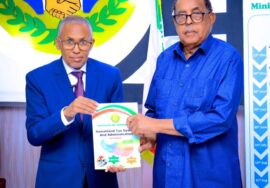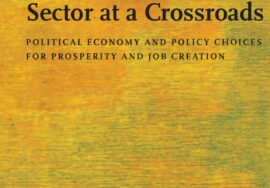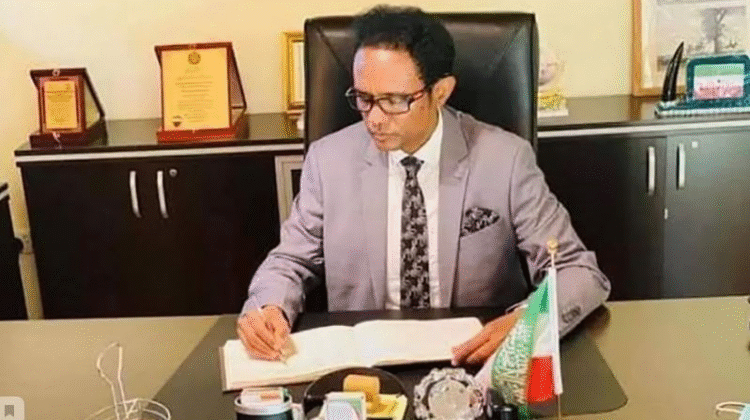
Horn of Africa Economic Integration
SOMALILAND – ETHIOPIA RELATIONSHIP:
AN INITIATIVE FOR REGIONAL ECONOMIC INTEGRATION AND DEEPENING POLITICAL STABILITY IN THE HORN OF AFRICA
ABSTRACT
This paper is going to analyze and light on the political, economic, and trade cooperation between
Somaliland and Ethiopia, the paper explores how Somaliland and Ethiopia’s bilateral rel
sustained to the existing political context based on the status of de jure concept of statehood and de
facto statehood Ethiopia and Somaliland respectively .The paper will also attempt to find out the
political and trade implications encountered by both parts in their performance of
and economic relations. Despite that Somaliland is unrecognized state, it is notable to highlight that
the prolonged sustained de factor status had led political maturity of Somaliland over the p
which de facto state sustaining its display for more than two decades and half
customary law in the eyes of international community, which Somaliland has proved its competence
to contribute security interests of its neighboring states, regional and international and because of this,
Somaliland is gaining political legitimacy and becoming an important hub of trade cooperation
because of its geopolitical strategic location in the Horn of Africa and Gulf of Aden. Somaliland has
also demonstrated the capacity and capability to enter bilateral and multilateral deals and there are
many regional states and wider international community members who are dedicated to promote the
democratic credentials and peacefulness in Somaliland, in the meantime, Ethiopia is second largest
population in Africa, fastest economic growing and diplomatic home of the African Union.
This paper is going to analyze and light on the political, economic, and trade cooperation between
Somaliland and Ethiopia, the paper explores how Somaliland and Ethiopia’s bilateral rel
sustained to the existing political context based on the status of de jure concept of statehood and de
facto statehood Ethiopia and Somaliland respectively
political and trade implications encounter
and economic relations. Despite that Somaliland is unrecognized state, it is notable to highlight that
the prolonged
which de facto state sustaining its display for more than
customary law in the eyes of international community, which Somaliland has proved its competence
to contribute security interests of its neighbor
Somaliland is gaining political legitimacy and
because of its geopolitical strategic location in the Horn of Africa and Gulf of Aden. Somaliland has
also demonstrated the capacity and capability to enter bilateral and multilateral deals and there are
many regional states and wider international community members who are dedicated to promote the
democratic credentials and peacefulness in Somaliland,
population in Africa, fastest economic growing and diplomatic home of the African Union.
by both parts in their performance of diplomacy, security
and economic relations. Despite that Somaliland is unrecognized state, it is notable to highlight that
status had led political maturity of Somaliland over the period,
two decades and half created an international
customary law in the eyes of international community, which Somaliland has proved its competence
ing states, regional and international and because of this,
becoming an important hub of trade cooperation
because of its geopolitical strategic location in the Horn of Africa and Gulf of Aden. Somaliland has
also demonstrated the capacity and capability to enter bilateral and multilateral deals and there are
many regional states and wider international community members who are dedicated to promote the
the meantime, Ethiopia is second largest
population in Africa, fastest economic growing and diplomatic home of the African Union.
INTRODUCTION
Since the reinstitution of Somaliland’s sovereignty in 1991 and
on the borders inherited on date of attainment of independence
on 26 June 1960. Somaliland has made notable progress in
building peace, security and constitutional democracy within
its de facto borders.1 The reestablishment of Somal
sovereignty in 1991 and
on the borders inherited on date of attainment of independence
on 26 June 1960. Somaliland has made notable progress in
building peace, security and constitutional democracy within
The reestablishment of Somaliland has
reduced tensions and border conflict between Ethiopia and
Somali Republic before in 1991 and this has paved the way
laying the foundation of long lasting peace in the horn.
Somaliland and Ethiopia share a long border with 850
secure, safe and peaceful. The existing
reduced tensions and border conflict between Ethiopia and
Somali Republic before in 1991 and this has paved the way
laying the foundation of long lasting peace in the horn.
Somaliland and Ethiopia share a long border with 850
kilometers which is secure, safe and peaceful. The existing
relations between Ethiopia and Somaliland at various fronts
among them economic, diplomatic and security have been won
through the concerted efforts of many people from both
governments with my part being genuine and
facilitation and the like. Many Somaliland intellectuals and politicians are optimistic
that Somaliland – Ethiopia relationship is indispensible and
avenue to advance widening East Africa regional economic
integration, political stability, security cooperation and people
to people relations. Similarly Ethiopian policy
Many Somaliland intellectuals and politicians are optimistic
Ethiopia relationship is indispensible and
advance widening East Africa regional economic
integration, political stability, security cooperation and people
Similarly Ethiopian policy- makers many
times repeated that Ethiopia is committed that it is
and economic ties with Somaliland.
times repeated that Ethiopia is committed that it is
strengthening its security and economic ties with Somaliland.
In the meantime, it is unavoidable reality that Somaliland and
Ethiopia are in a region characterized by violent conflicts,
droughts, civil wars and instability which made the Horn of
African Region more vulnerable, chao
In the meantime, it is unavoidable reality that Somaliland and
Ethiopia are in a region characterized by violent conflicts,
droughts, civil wars and instability which made the Horn of
African Region more vulnerable, chaotic and underdeveloped.
Moreover, it is clear that this vibrant bilateral relationship
between Somaliland and Ethiopia has extensively contributed
security and attempting to facilitate
Moreover, it is clear that this vibrant bilateral relationship
between Somaliland and Ethiopia has extensively contributed
in deepening peace, security and attempting to facilitate
regional economic and political cooperation, in the
African region, there are initiatives encouraging mitigating
barriers of the cross- border trade and utilizing the full
potentiality of the regional and subregional market.
the reason that subregional organizations have been established
included the common market for Eastern and Southern Africa
(COMESA), the East African Community (EAC) and Indian
Ocean Commission (IOC) to promote regional economic
integration and strengthening economic cooperation between
these countries. Regional integra
regional economic and political cooperation, in the East
African region, there are initiatives encouraging mitigating
border trade and utilizing the full
potentiality of the regional and subregional market. And this is
the reason that subregional organizations have been established
ncluded the common market for Eastern and Southern Africa
(COMESA), the East African Community (EAC) and Indian
Ocean Commission (IOC) to promote regional economic
integration and strengthening economic cooperation between
these countries. Regional integration in East Africa is a
complex and uneven process: some regional organisations and
policy areas have recorded significant progress, while others
are lagging behind.3 Somaliland and Ethiopia also share some
historical relations because the current government of
Somaliland and current government of Ethiopia were all
emanated from liberation movement and social upraising led
by Somali National Movement (SNM) and Tigrayan People’s
liberation
Front (TPLF) later on Ethiopian people’s
Revolutionary Democratic Front (EPRDF) both rebel
movements fought regimes of Mengistu Haile Marian and
Mohamed Siyad Barre which were concurrently overthrown in
1991 through deadly and bloody civil war. Moreover, the two
countries shareexperiences in managing this conflict prone
region. Ethiopia is attributed as a regional power that plays
very vital role in the regional stability, development and
economic integration. On the other hand, the Federal
Democratic Republic of Ethiopia is the first country among
other African states to open its consulate in Hargeisa
Somaliland.
This consulate general is now issuing visas to Ethiopia with
the Somaliland passport and Ethiopian Airline was also the
first international commercial airline transport landed in the
Somaliland soil. It should be noted that Ethiopia‘s diplomatic
relations with Somaliland is more trustworthy in many ways4,
whilst Somaliland as de facto state sees Ethiopia as ally and
strategic partner in the Horn of Africa. Hence, the diplomatic
and trade relations between two countries revealed a level of
political maturity that currently driving by the mega projects of
the economic development as infrastructure of the roads
development and ports modernization, electricity and
improving trade incentives marketable across the globe.
Ahmed Shide, Minister of Transport, told Capital that Ethiopia
wants port expansion and development in every corner of the
region. “The port at Berbera will be an alternative for the big
population and fast growing country like Ethiopia. The issue
has been notified by Ethiopia to its regional partners,” he said.5
Somaliland and Ethiopia have reached some strategic
partnership framework of agreements in order to boost the
regional economic development, infrastructure and security
cooperation, both countries are committed to strengthening
their bilateral relations and maintaining the peace and stability
in the region of the greater Horn of Africa. Holding talks with
Somaliland President Ahmed Mohamed Mohamoud yesterday,
Prime Minister Hailemariam said the economic and political
cooperation between the two countries would be strengthened6.
Subsequently the two countries also share a long border where
the pastoral and nomadic communities live side by side and the
livestock cross- border trade has substantial economic
contribution and trade flow. The cross-border livestock trade
between Somali Region of Ethiopia and Somaliland passes
through two major clan areas, and has long been influenced by
them. The cross- border livestock trade -CBLT between the two goes through the Berbera corridor, coming through
different trade routes.Therefore, it is incontestable that Somaliland and Ethiopia
relationship fascinated some international opportunities such as
United Arab Emirates investment to the Berbera port and
Berbera corridor in which Ethiopia wants to shift some of its
commercial activities and this tripartite deal between
Somaliland, Ethiopia and United Arab Emirates has significant
potential economic impact throughout the region in the Horn
and East of Africa at large. The Ethiopian Minister of
Transport Ahmed Shide stated the following “In the case of
Berbera we are not just considering using the port we are also
looking at the tripartite investment possibilities,” he added.8
Moreover, this paper discusses how this bilateral relationship
between two countries is sustained and how the wider region
of the greater Horn of Africa can be benefited and utilized this
mutual diplomatic, security and trade agreements between
Somaliland and Ethiopia, the paper will also explore what are
legal and political implications that each party has faced so far,
for instance Somaliland is a de facto state which the African
Union has not yet recognized where Ethiopia is playing a
leading role in the issues of the continent and greater Horn of
Africa particularly and the African Union Head Quarter is
located in the capital city of Addis Ababa, Ethiopia where
Ethiopia involves numerous interventions in the region as
AMISOM troops in Somalia. In addition, Somaliland situates
the whole heart of Ethiopia in terms of economy, trade,
security and fight against terrorism, Somaliland is a coastal
state and it manages longest red sea close to the international
shipping system of Baba- Mabda and Gulf of Aden where
Ethiopia is landlocked country with more than population of
90 million. “At present time Somaliland and Ethiopia are
cooperating macroeconomic development projects that will
contribute
the
wider
regional economic integration,
infrastructure, networking and import and export trade
activities said” Somaliland Minister of Trade and Investment
Dr. Omar Shucayb.9
Somaliland has recently signed a landmark trade deal between
the Republic of Somaliland and Dubai’s Port World on May
2016, which was intended to expand and modernize the
Berbera port facilities and road infrastructure in order to
sustain the cross- border trade and transit agreements between
two countries whereas the Berbera Port is heading as a regional
hub and the main getaway for Ethiopian and other landlocked
countries such as South Sudan. Finally, the recent diplomatic
activities of exchange delegations and trade deals between two
sides are indicating opening a new chapter of trade and
economic development that may enlarge the peaceful co
existence and mutually understandable relations of the two
countries. Somaliland and Ethiopia relationship can be an
instrumental either political or establishing well- connected
economic atmosphere which the rest of the region is beneficial.
The two countries collaborate a number of areas including
regional stability, security, intelligence sharing, migration,
human trafficking and promoting regional economic
integration and infrastructure development initiative underway.
Fundamentally, the Somaliland Government has paid special attention to the situation of Ethiopia’s landlocked status and
the opportunities that entails.10 Nonetheless, it is indisputable
that Somaliland and Ethiopia share exceptional history of
successfully managing the post- conflict arena in the violate
region in the Horn, in addition, they share communal interests
that
strategically
fundamental, politically viable, and
economically advantageous, the paper gives more emphasis on
the growing diplomatic and economic ties which the expansion
of the Berbera port invested by the Dubai Port World is one of
the accelerating benchmark of this mutual relationship of the
two countries. The Republic of Somaliland is angling to
become a trade and transit hub for East Africa, pouring
millions of dollars into infrastructural development with the
help of international financiers.11
Somaliland – Ethiopian Trade Relations
Somaliland and Ethiopia share a long border that both legal
and illegal trade movements cross on daily basis, Somaliland
owns largest maritime resources in the Horn of Africa where
Ethiopia is demographically growing, and Ethiopia ranked the
second population country in the Sub- Saharan Africa,
estimated 100million with rising economy. Ethiopia and
Somaliland agree on importance of transit cooperation
mechanisms Ethiopia and Somaliland agreed on Monday
(January 6) to exercise maximum effort to establish short and
long-term transit cooperation mechanisms.12 Notwithstanding,
aftermath of the peace and political stability in Somaliland was
sustained, there was a growing aspirations towards developing
a
comprehensive transit and trade agreement between
Somaliland and Ethiopia. Some series of bilateral discussions
mainly started in 2002 to scale up the trade cooperation. If
anything can be termed as the most impactful of my tenure as
the Ethiopian Consul General in Somaliland, then it is this
currently
operational
Pact
Enhancing
Economic
interdependence between the two neighboring and friendly
sides.13 In fact, the trade partnership between Somaliland and
Ethiopia has concurrently increased when some international
investors committed to invest the Berbera port as major hub of
transit to Ethiopia and other landlocked countries in the East
Africa. At moment there is anoptimistic sign that there are a lot
of opportunities that both sides can maximize. Ethiopia
government and Somaliland government cooperate in many
areas which may facilitate the way forward and trusted
relations of economic integration and political cooperation is
necessary whilst the region of the Horn of Africa is too behind
due to persistent violent conflict which invariably affected
socioeconomic, security and political stability. On the other
hand, the disparity of the two nations in terms of population
and size is an indicator that trade deals between two countries
are asymmetric and should require more in depth negotiations
and series bilateral conciliations. Measurable trade flows can
enhance balancing the transactions of cross- border trade as import and export activities. It is notable that Ethiopia
government seeks alternative routes of its trade activities and
Somaliland seems to be a best option and suitable route of
trading since this natural port of Berbera is too closer
compared to many ports in the region as EU Berbera corridor
feasibility study (2003) revealed. The trade cooperation
between two sides is progressive but the absence of required
economic infrastructure and regulatory framework which both
sides are needed to demand assistance from the Africa Union,
World Bank, EU and intergovernmental organization of IGAD
help partsto set up more comprehensive trade deals.
States with integrated and interdependent economies are less
likely to get into conflict with more integration and
interdependence.14 The Kumiye Party chairman and
presidential candidate 2017 elections in Somaliland Muse Bihi
Abdi stated while he was mobilizing his supporters in Haji
Salah district on July 10, 2017 “the struggle of Somali
National Movement (SNM) was not only aimed to overthrow
the Siyad regime who made crimes against humanity but to
bring a long lasting peace in the Horn of Africa between
Somalis and Ethiopians and to get rid of the hostile attitudes
among those who are living side by side.” Nonetheless, the
market of both sides Somaliland and Ethiopia seem to be
exhausted how to regularize trade deals that should foster the
marketability and potentiality of this competition. The Horn of
Africa region experienced so many conflicts that constantly
undermine the potentiality of the natural resources and
attainment of the foreign direct investments. Over the decade,
Eastern Africa has been plagued by civil wars, cross-border
conflicts, social strife, and arms trafficking. Current security
concerns in the region include the volatile situation in Somalia,
conflict in Darfur, stalemate between Ethiopia and Eritrea,
Djibouti-Eritrea conflict, piracy off the coast of Somalia.15
Foremost, Ethiopia and Somaliland were struggling many
years to set up an enabling economic environment, from this
long term efforts, there were trade negotiations and ongoing
dialogue which mainly looking forward trade and transit
agreements to be signed and implemented. “Somaliland people
strongly believe that Ethiopia market is more potential and
strategic whereas Ethiopia at same time is committed to use
several ports included Berbera port as inevitable policy option
since the country is landlocked.16 Since the independence of
Eritrea, Ethiopia became a landlocked country and access to a
deep sea port became a major constraint for its foreign trade
and for the provision of food aid. The Government of Ethiopia
is therefore anxious to secure as many routes to access sea
ports as possible.17Indeed, the economic integration, transit
management, transport connectivity and establishment of the
institutional framework for trafficking passage of goods and
safe corridors are all commonly workable regionally,
internationally and at global scale of economic activity. But
Somaliland and Ethiopia still far behind to accommodate such
interconnectivity and fostering the scale of transit passage.
Market position-Somaliland’s geographic position plays to its
favor in multiple directions. Berbera is well-placed to serve
shipping though the Red Sea and enjoys excellent access to the booming economies of South Asia, the affluent economies of
the Gulf States, and the emerging economy of Ethiopia18. One
of the trade incentives is the peacefulness of Somaliland as
well as the willingness of the society to pursue the trade
cooperation between the two countries. In addition, the
military base agreement between Somaliland and UAE signed
on March 2017, the Somaliland Minister of Foreign Affairs Dr.
Sacad Ali Shire declared that UAE government will invest the
Berbera corridor which is the main trade exit between
Somaliland and Ethiopia.
Khat Trading between Somaliland and Ethiopia
Somaliland has become a biggest market of the Ethiopia khat
selling and exporting site, and the khat products reach in
everywhere of Somaliland either small towns or large cities
and there are thousands of people addicted where the khat has
become one of the society daily lives and cultural gathering.
The khat trading flow is estimated $530 million a year as
Ministry of finance of Somaliland revealed, in fact, this is
more deeply rooted habit across the Somaliland and thekhat
business transactions is highly pressurizing the outflow of hard
currency in everyday and truly speaking this is a capital fly.
Khat trading was going on many years and Somaliland local
communities values it as promoter of the social integration and
in deepening cultural ties as marriage and other cultural
festival. The largest khat trade network in Somaliland was
established in the late 80s and early 90s,19 one can point out
that accessibility and reliable security of border between
Somaliland and Ethiopia scaled up the level of khat delivery
through effective transport networking and communication.
From this trade point of view, Somaliland is arguing that khat
needs to be exchanged other natural products that Somaliland
bestowed such asfish and salt. Hence, any trade negotiation is
required to give more attention this open and unregulated
market of khat. However, critics warn that the flipside to this
economic uplift is that Somaliland’s fragile economy loses a
large percentage of its foreign currency through this trade. The
country reportedly spends $524m a year – about 30% of GDP – on khat imported from Ethiopia.20On the other hand,
Somaliland government generates a revenue estimated
500million of Somaliland shilling on daily basisas Ministry of
Finance has confirmed itwhich is yearly 30million USD.
Furthermore, there are also a lot of criticisms on khat chewing
which affects the working hours of the countries because
anyone who chews khat cannot tolerate along working day
hours, it may also directly affect health of individuals due to
consumption of the khat, there are other consequences of
socioeconomic and human productivity, some doctors say the
khat is more dangerous than the alcohol. The prevalent view
aboutkhat indicates the chewing khat has truly become one of
the social problems that Somaliland today is struggling with
and this bitter leaf proved its harmfulness and economic
negative impact. Some people here in Hargeisa the capital city
of Somaliland, expressed their views that the khat is the loss of
the economy because everyday consumption and there are
some explicitly and implicitly factors that khat causes at family level and society in general. In the meantime, the khat
generates some income at household level because there are a
lot of people work for khat trading but the remittances transfers
abroad is more viable at household income generation and
boosting the economy at macro and micro level. Remittances
inflows to over 40 percent of households are a major economic
lifeline to Somaliland. Remittances estimates for Somaliland
range from US$500–900million per year, equivalent to 35–70
percent of GDP21.As far as many Somalilanders are concerned
the khat trading from Ethiopia is most effective cross – border
trade transactions and it is outstanding issues how the khat
trading moves from Ethiopia to Somaliland across regions
smoothly with less taxation, peaceful and deregulated
environment.
Eventually, Somaliland often demands return from Ethiopia in
the exchange of khat, and this can be a valid argument when
you observe the situation of Somaliland, but Ethiopia is also
arguing that Somaliland did not yet succeed to prepare reliable
supply of chain like fish to provide Ethiopian growing market,
and this is not the fault of Ethiopia but Somaliland must
develop its natural resources that Ethiopia needs and this may
create a trade balance and sustain the trade cooperation
between two countries.
Livestock Trade between Somaliland and Ethiopia
Considering the livestock trade, the Somali region in Ethiopia
has access to all markets of Somaliland, despite the political
and border management of the two countries, the livestock
traders cross the border is myriad throughout seasons and
Berbera port is naturally the hub of the livestock trading across
the Somali peninsula because the livestock comes from all
Somali regions as Kenya Somali region as well as Ethiopia
Somali region ended up to Berbera port. Somali Region and
Somaliland share similar ecological conditions, strong
economic and social ties and clan affinities. Customarily,
pastoralists utilized grazing areas on both sides of the border as
part of seasonal movements with herds to access key resource
sites.22 Thus, the livestock trade contributes the GDP in
Somaliland nearly 30% as the World Bank study (2016)
indicated, hence, the livestock trade between Somaliland and
Ethiopia is not much regulated because the nature of the
society who are mostly nomadic that depends on the rainfall
seasons without considering the cross border protocols and
regulations that both countries developed to control the border.
Ethiopia is committed to regulate the cross- border livestock
trade where Ethiopia authorities hardly struggling to control
outflow of the livestock from Ethiopian Somali region to
Somaliland. The Ethiopian government has long considered
the cross-border livestock trade to be illegal23but it cannot be
dismissed the realities surrounding the environmental
connectivity and people to people relations based on the
Somali culture as blood relations, marriage and kingship.
In Somaliland, the livestock export is a major domestic product
which is exported widely. Livestock production has been the
mainstay for the people of Somaliland. Livestock production is predominantly pastoral and agro pastoral employing over 70%
of the population. Livestock production contributes 60% of
GDP and about 85% of foreign export earnings.24 But the
climate change, environmental degradation and incessant
droughts seriously affected the potential market of the
livestock in the recent years. As far as the nomadic pastoralists
are concerned, there are enormous challenges and problems of
the livestock trade market which is designed more natural type
of trading because of several times the livestock trade was
banned by the Saudi Arabia. Since then there is no agreement
between Somaliland and Saudi Arabia, the livestock trading is
presumably has unpredictable trends upward and downward
compared to khat trading which is constant in terms of amount
export to Somaliland from Ethiopia and Khat includes cross
border trade items between two countries. Therefore, the
Somaliland government and Ethiopia government are being
required to collaborate tackling the challenges around the
livestock trading and livestock development as well. Any
regulations that both government attempt to develop for the
control of the livestock trading should be needed to further
examine the characteristics of the society, geographical
understanding of the nomadic people and their perception of
the state control of the territory.
The free passage movement of the livestock seeking pasture
and water throughout cross border which entirely adopted by
rural communities in both sides, it has been very difficult for
the Ethiopian Customs and Revenue Authority (ECRA) to
strictly police and control this trade.25 Thus, understanding the
livelihood of the nomadic people in both countries in this
contemporary period is complex and very dynamic to the
extent that state restrictions are contrary to the way of life
which some social norms and traditional values dictate to those
attributes of socioeconomic and political grounds. Despite,
livestock trading, the nomadic communities in Ethiopia and
Somaliland are the major people who contribute the
relationship of the two countries and in many times there are
some security implications because of the clashes between
these communities who come together or live together the
border between both sides. In the recent past the both countries
suffered the severe and recurrent droughts that potentially
affected the livestock trading and supply chain of the livestock
trade flow to Gulf countries such as Saud Arabia. Furthermore,
in the livestock trading often accompany with other
commercial activities where mostly the Somali region of
Ethiopia depends on the commodities from Berbera port. On
the other hand, there are some predictable constrains for the
time being because the recurrent droughts, diseases, increasing
rural – urbanization migration, modernization, technological
advancement and the climate change affected the overall
ecological conditions and marketable livestock trading and this
may result the decline of the livestock market. Moreover,
Somaliland and Ethiopia have diverse interest in this area of
the livestock trade for example in Somaliland the livestock
trading generates government revenue in its yearly budget and
mobilize other opportunities. But the Nisar Majid believes that
Ethiopia is looking forward to obtain more foreign hard
currency because in Ethiopia is barely required foreign currency. One of Ethiopia’s major interests in the livestock
trade is said to be obtaining foreign currency.26
The livestock is managed similar to the ancient times, no
modification of the products of the livestock production and
caring for and the livestock in the greater Horn of African in
general does not enjoy much infrastructure needed except
recent quarantines built in Berbera, Boosaaso, Mogadishu and
Djibouti, likewise the livestock did not get a substantial
amount of investment and competitive market. Moreover,
Yemen business people before the war in Yemen trading the
Somali livestock and this has created more chances, thought,
the prices of the livestock market sets by the individual traders
and the free market and this has apparently posed the risks and
uncertaintyof the Somali livestock trading. In the meantime,
Saudi Arabian ban to Somali livestock in the Horn will hugely
affect the current market decline and no longer should the rural
communities’ resilience be maintained. Indeed, the clans’
conflicts may not be a potential factor to affect the market but
the global hazards such as climate change and severe
ecological situation remain more invariable and unendurable.
As the social structures of the nomadic people changing from
time to time for intimidation of the modern livelihood, the
livestock is also needed to alleviate current hardship conditions
by transforming the present livelihood of the livestock in the
Horn of Africa. Finally, in this area of livestock trading
indicates less implication of political and legal aspects “since
these business and commercial transactions are connected with
more traditional and social ties which either Ethiopia or
Somaliland cannot dictate in the onset.”27Hence, such free
passage of the livestock trading is threatened by a number of
challenges included the market instability, diseases and
dramatic evolution of the social livelihoods as rapid
urbanization and delicate ecological conditions.
Importance of Berbera Corridor and Berbera Port
Modernization
The Berbera corridor project is recognized as one of the
biggest regional economic and trade infrastructure that
bilateral and multilateral organizations of IGAD, AU, EU,
African Development Bank and World Bank and member
states are optimistic that this Berbera corridor as roads
development and Berbera Port modernization should generate
more employment, enhance regional interconnectivity,
economic integration and safe passage of transit and trade flow
of the region.“We expect Somaliland to be a growing trade
centre in east Africa and are positioning ourselves to meet and
cater to the demand,” says deputy CEO Esayas Ethiopian
Airlines Woldemariam Hailu.28 Berbera is the only other port,
apart from Djibouti, on the northern coast of the Horn that is
able to serve the Ethiopian highlands,29 thus, there are lot of
regional and international attention on the Berbera corridor
project, and as many studies about the Berbera corridor
identified, Berbera port has a high significant route of trading
both in the close distance of the international shipment and
Ethiopia. Moreover, the history of Berbera corridor project was
imminent for long time, there were attempts for different times
that the corridor was extensively anticipated to implement and
in the contemporary history the Republic of Somaliland and
Federal democratic Republic of Ethiopia held series of talks
about the infrastructure development of the Berbera Port and
maximizing trade channels included transit passage
management and facilitation. The Berbera Corridor idea was
started in 1896 by the Somaliland Elders and UK Government,
jointly they submitted the idea to the Cadan Governor and also
the governor forwarded to the UK House of elders and then
UK sent a high delegation to the Ethiopian Kind
Mililk.30Therefore, the ambition of Ethiopia to have access to
Berbera Port facilities as the passage of export and import
which the transit corridor is more central regionally and
internationally beneficial at this level of accessibility and
conducive trade environment. On the other hand, Somaliland
to advance its seaport of Berbera will mutually advantageous
for the economic growth of the greater Horn of Africa as
rapidly growing economy of Ethiopia. Nonetheless, both
regional and international actors strongly believe that the
Berbera corridor is a vital for regional and international
shipment system since the Berbera is naturally capable to
handle such international shipment in this deep water harbor,
international
community exceptionally encourages the
development of the Berbera corridor and use of Ethiopia as
workable alternative route.
The bilateral agreement between Somaliland government and
Dubai Port World in 2016 was intended to scale up the level of
the Berbera Port facilities as the biggest container traffic site in
the East Africa and Middle East. In a meeting between
Somaliland officials and Ethiopia’s Consulate General Office
in Hargeisa, the two sides discussed details of the opportunities
and challenges on usage of transit services raised by both
sides.31 In fact, this project of the Berbera corridor in one hand
is joint venture between Somaliland, Ethiopia, UAE and
regional economic development partners on the other. DP
World Port of Berbera will offer East African importers and
exporters a unique, additional world class deepwater port that
will dramatically improve the competitiveness of their
products in world markets and has the potential to transform
the region’s economy,” added Dr. Saad Ali Shire, minister of
foreign affairs and international cooperation of the Republic of
Somaliland.32 The European Commission has financed the
preparation of a feasibility study and detailed design for the
rehabilitation of the road from Berbera to Tog Wajaale, with a
total estimated cost ofUS$276 million for the 268 kilometre
long road.33As the Horn of Africa region is characterized by
more backward indicators such as poverty, insecurity, droughts
and conflicts, the Berbera corridor agenda is to create
conducive economic partnership that should offer the rest of
the region more accessible and credible port services which is deliverable and timely. Thus looking the regional and
international views about this agenda of the Berbera corridor
are all constructive and portrayed continued international
community engagement regarding the multiple studies and
researches made for the benefit of the Horn of African region
to enlarge its economic integration and trade infrastructure, the
Berbera corridor is meant to be a vehicle for macroeconomic
regional development that can encourage the competitiveness
of the private sector innovative interventions, global trade
routes, regional and international market.
Moreover, it is notable to highlight that the Horn of Africa
region has more economic potentiality and natural resources
endowment, despite the region has been struggling to tackle so
many challenges of unemployment, lack of clean water, poor
health facilities, high mortality rates, food shortage as well as
poor livelihood conditions. The subregion has experienced
severe economic problems especially during the last decade,
emanating from a host of factors: first, climatic problems have
contributed to overall decline in food production, and second,
unfavorable world market prices for agricultural produce have
been persistent.34 Some reports discovered that the climate
change hugely affected in this region in the Horn of Africa
specially the livestock trading and enhancing the trust and
regional cooperation is inevitable in order to sustain the
regional economic initiatives which the Berbera corridor will
be under the high priority category. Improving regional
infrastructure connectivity can help to improve human
development and business competitiveness, and can also help
to
strengthen trust and cross-border collaboration.35The
dialogue between Ethiopia and Somaliland has commenced the
earlier in 1995 since then some progress was made, although
not yet matched the expectation of Ethiopia keenness of the
import and export trade because the Berbera traffic is too low
for the time being.
Moreover, this dialogue was recently accelerated both sides
and there were ministerial meetings and technical committees
that held a roundtable discussions and conferences which
mostly focusing on the transit and trade issues but the need for
port modernization and road development hampered the dream
of the two countries to establish a viable negotiations. In fact,
investing the Berbera corridor will increase the volume of
economic capacity, innovation and expansionism of the trade
which the free trade zones and transit arrangement are the
driving modality. Economic development corridors also
provide opportunities for private sector investment in the
provision of transport infrastructure associated with the
exploitation of some resource in another sector.36 In 1995 the
Government of Somaliland sent to Ethiopia first a delegation
composed of vice president, Abdirahman Aw Ali Farah,
Minister of Interior Muse Bihi Abdi and Ahmed Mohamed
Mohamoud Silanyo Member of Parliament and the delegation started the first relationship with Ethiopia37,this is nearly three
decades that the Ethiopia and Somaliland ongoing trade
discourse underway but this time the regional actors,
international investors, bilateral and multilateral institutions
have all a consolidated point of view for the implementation of
the Berbera corridor. It was remarkable and historical that
Somaliland Minister of Foreign Affairs Dr. Sacad Ali Shire
signed an agreement on July 2017 between Somaliland and
UAE to construct 250km road connecting with Somaliland
seaport of Berbera and Tog Wajale town of the border and this
was the exchange of the UAE military base of Berbera as well
as DP World investment to Berbera port accompanied with 30
years port management. The agreement signals the beginning
of the construction of a 250-kilometre road connecting Berbera
to the border town and commercial hub of Wajale, straddling
the boundary between Somaliland and Ethiopia.38
Therefore, to speed up the corridor project included
Somaliland and Ethiopia transit and trade agreement remains
high priority, the successful implementation of the Berbera
Corridor could serve as a regional model for development
through expanded private sector activities and a coordinated
multispectral
program of infrastructure investments.39
Somaliland and Ethiopia also discuss how Ethiopia provides
hydroelectricity to Somaliland, getting affordable energy in
Somaliland is crucial and has become a pre- condition for the
foreign direct investors aspiring to invest Somaliland.
Eventually, from Somaliland side many intellectuals consider
that
the
Berbera corridor is widely contributing the
sustainability and mutual relationship between two countries
and this will also raise more economic opportunities that
would promote the movement of people to people and linkage
of other sectors development initiatives as, Fisheries, tourism,
agriculture, livestock oil, gas exploration and mining , the
paper will further discuss increasing the foreign direct
investment about the Berbera corridor and challenges needed
to mitigate across this program. Some initial views pointed out
that the financial sector is an important instrument for
international investors, in contrary, Somaliland which is 100%
Muslim country, opening the conventional banks has become
impracticable because Islamic shari ‘a prohibits the interest
rates so there is a big dilemma in this area of financial
institutions and many people are arguing that Somaliland needs
conventional banks with Islamic window or Islamic system,
insurance and competent transport networking is imminent and
vital at this time. The EU feasibility study has made this
classification for the corridors in the region, in which specifies
the
entailed comparative benchmarks as distance and
accessibility to Ethiopia, Addis Ababa hence, this below data
analysis gives us more insightful and generated options of
cost- effective and transport viability, in this regard, Berbera
corridor is more competitive than the rest of corridors in
below, Currently Djibouti is the major route that Ethiopia trade
activity depends on and in terms of distance Djibouti corridor
is about “781” while Berbera is “937” however, the Berbera
corridor is the second competitive trade site in Ethiopia since
the political relationship between Ethiopia and Eretria is not unhealthy and this EU study has also pointed out that in the
future reopening the Assab and Massawa will not be
considerably upsetting the Berbera “traffic” but Djibouti is
likely since it provides the “Northern regions of Ethiopia. ”The
corresponding corridors are:
• The road to Port Sudan (distance between Addis Ababa
and Port Sudan is1,900 km);
• The road to Mombasa (distance between Addis Ababa
and Mombasa is 2,067 km);
• The road to Assab (distance between Addis Ababa and
Assab is 882 km);
• The road to Massawa (distance between Addis Ababa
and Massawa is 1163km); and
• The road to Berbera (distance between Addis Ababa
and Berbera is 937 km) via
Harar, Jijiga, Togochale, Kalabeit and Hargeisa.40
To this end, advancing Berbera port facilities may revitalize
the current attempts to improve wider regional and subregion
economic integration and increasing the size and the volume of
the transactions and mode of transmission, there are some
apparent challenges of poor infrastructure as roads, low
handling capacity of the port at moment as well as competing
political views both regional and international arena on issues
of the Berbera corridor.
Somaliland and Ethiopia Dialogue on Transit Passage
Ethiopia as landlocked country, the second populous in Africa
and fastest economic growing country in Sub- Saharan region,
access to sea and enjoying trade connectivity as transit passage
is a central objective and economic incentive that Ethiopia is
maximizing its efforts to get multiple routes of trade sources,
in 2016 Somaliland and Ethiopia signed a memoranda of
understand of opening the transit from Berbera port to Ethiopia
and one of the technical committee from Somaliland side
stated that this was as major step forward. Despite the MOU
signed, there were several rounds of negotiations that Ethiopia
was pushing forward its goods to be facilitated through transit
means and as the convention, Statute on Freedom of Transit
(1921) indicated the landlocked countries have a right to
access to the sea and safe passage for their goods and transport.
Article (1) illustrates what type of goods to be transferred and
how this process is coordinated “Persons, baggage and goods,
and also vessels, coaching and good stock, and other means of
transport, shall be deemed to be in transit across territory under
the sovereignty or authority of one of the Contracting States.41
Somaliland and Ethiopia need to increase the level of
negotiation in this transit management bearing in mind the
international declarations and regional instruments on the
freedom of the transit goods which should require more
structured, competent institutions and consolidated legal and
policy framework. From this point forward what matters the
issues is in one hand the – the imbalance of power of two
states, although, Somaliland enjoys peace, democracy and
demonstrated its willingness to foster East Africa economic
integration despite the absence of the international recognition,
there are strong historical, social, economic, political and cultural ties between the two countries which primarily
enhanced the current maneuvering of Ethiopia to access this
deep- water port of Berbera. Furthermore, the trade and transit
dialogue took many years; one could realistically justify that
geopolitical dynamics and the greater political disparity of the
states structures can be reasonably a factor of the perpetuating
the trade deals, when you talk the Somaliland politicians they
are all 100% confident this growing relationship between
Somaliland and Ethiopia particularly the trade and economic
integration and from Ethiopia side the successive Prime
Ministers demonstrated a good faith and momentum to
advancethis significant deal of the transit agreement and
improving the corridor infrastructure. In the light of the
continued interest of Ethiopia to use the Berbera port has also
entertained more international competitive investors to seek
the management of the port facilities and the DP World based
on Dubai has made a landmark agreement with Somaliland in
2016. Somaliland government signed a deal with $442million
with DP World to modernize the Berbera Port aimed at
delivering transit goods to Ethiopia, and this will rapidly
transform the chain of trade activities between the two
countries.
Thus, Somaliland’s focus was many years to create a trade
atmosphere between two nations but this deal of the DP World
has fascinated Somaliland to realize its long term dream of
economic partnership with its largest Horn of Africa neighbor
country of Ethiopia and modernization and expanding Berbera
Port facilities as a new container terminals and road
development from Berbera to Tog Wajaale is a big deal that
can absorb more international investors.“We are delighted to
extend our African footprint with a major investment in
Somaliland. Investment in this natural deepwater port will
attract more shipping lines to East Africa and its modernization
will act as a catalyst for the growth of the country and the
region’s economy,” DP World Group Chairman and CEO
Sultan Ahmed Bin Sulayem said in a statement.42 The deals
with the UAE could help return Berbera to its former
prominence. The $442 million, 30-year port deal with Dubai
Ports World (DPWorld), passed by Somaliland’s parliament in
August 2016, would boost annual container capacity twenty
fold.43However, the transit deal with Ethiopia is yet under
negotiation circles which are unfinished business for long time,
the pursuit of the Berbera modern container terminals
following the free trade zone for all commercial goods are
included this deal of the DP World. In the meantime, this
discourse of the transit corridor has both economic and
political scope that Somaliland can maximize for the quest of
recognition as member states of the African Union. The
overdue of the transit and trade agreement between Somaliland
and Ethiopia is not encouraging the amicable relations and
growing economic trends of the two countries, in fact, the
rhetoric and reality is different.
For instance the two countries have been pursuing these trade
negotiations for so long with good faith, one of the important
trade negotiations was held at Berbera city on Feb. 27 2016, in
this occasion, Somaliland Minister of Trade and Investment Hussein Adam Egeh that time extensively repeated how this
negotiation is crucial for both countries and he pointed out that
“Ethiopia has been a constant friend to Somaliland and a true
ally for along time, a friendship it has maintained even to the
extent of establishing a Diplomatic Missions in Hargeisa and
Addis Ababa.”
More important, the attainment of the international standard
criteria of the transit lanes will be most pressing agenda in
every negotiation; some technical persons from both sides
argue that genuine dialogue and greater political involvement
should be inevitable in order to materialize this compact of the
transit and trade agreement.
In addition, Somaliland business communities are very
optimistic that realization and rationalization in this trade and
transit agreement will be the foundation of the successful
economic integration that both countries put forward. Speak to
ministers and business folk in Somaliland and you’ll hear a lot
of talk about Berbera Port’s potential and what might be
achieved with the market opportunity offered by Ethiopia’s
100 million population – set to reach 130 million by 2025,
according to the United Nations.44This potential market of
Ethiopia is more predictable to contribute significantly the
regional economic development, infrastructure and free
passage of trade.
Moreover, there is a wider regional and international outlook
in this transit passage which Somaliland and Ethiopia are
necessary to further illustrate the provision of the rights of the
passage considering the regional and international legal and
policy initiative on the transit corridor. For transit, General
Agreement on Tariffs and Trade GATT borrowed from the
principles of, and at times reproduced verbatim, the provisions
of the 1921 Barcelona Convention and Statute on Freedom of
Transit45, therefore, these international instrument of tariffs
and trade, the rights of transit for landlocked countries,
customs and maritime are all encapsulating and illustrating the
heavy responsibility and international obligation that Ethiopia
and Somaliland must collaborate until a comprehensive
agreement to be reached.
Since Ethiopia and Somaliland commenced this initiative of
the trade and transit cooperation, the international investors
were dedicated to invest the Berbera corridor such as Port
expansion included new container terminals and road
development, may be in the near future the railway is likely to
start because the trade and cargo volumes and transit transport
is often an issues such conditions of the landlocked countries
in order to upgrade the scale of effectiveness and competition.
The two countries are also needed to create an institutional
framework for better understanding the corridor administration
by visualizing the challenges of this trade scale and transit
facilitation. At present time the road between Berbera and
TogWajaale border of Ethiopia is subject to be upgraded by the
United Arab Emirate, though the European Union has been
advocating the Berbera corridor for long time and secured
some funds but the domestic frustration of the poor economic
performance and high rate of unemployment triggered
Somaliland to evaluate a menu of options that international investors presented which finally the DP World succeeded to
manage these large –scale of projects under the Berbera
corridor.
Finally, there is a considerable economic interdependence at
regional level this time, Ethiopia and Somaliland have close
ties beyond the trade and transit cooperation, security and
diplomatic relations may underpin the mutual negotiations to
end up successful trade and transit agreement and both
countries are also needed to consider that the partnership
between landlocked countries and coastal states has had a long
term international interventions started from the league of
nations in the pursuant the united nations as well as other
bilateral and multilateral trade institutions both regional and at
global scale. In this regard, there are ranges of issues around
this transit passage such as legal and regulatory framework
where the international law is more central in the pursuit of
promoting such state to state relations should occur by
advancing the transit regime management and trade
facilitation, on the other hand, the international community
values such attainment of partnership looking forward more
comprehensive steps to be carried out by regularizing the
accessibility of the seaports and cost – effective transport
network. Ethiopia and Somaliland proved a close distance of
the cross – border trade and ingenuity of the people to people
traditional trade relations which posed less restriction.
Conclusion
To this end, Somaliland – Ethiopia bilateral relations seems to
be more progressive and based on mutual interests of
economic development, security cooperation and diplomatic
ties. Many people here in Somaliland see this relationship as
fundamental and workable, whenever, you go to the teashops
or marfarsh – a chewing khat places and intellectual gather
places, you may discover how social and political discussions
favor to this relationship going forward and the trade
negotiations underway as transit passage will allow both parts
to increase the level of commitment and better understanding
in the regional integration and creation workable regional
instrument
for
economic development, international
investment and better trade and transit regulatory framework.
Observing this relationship, one can also find out more
strategic dimensions of securitization, trade cooperation and
people to people relations due to this long border area between
two sides. The rural communities move frequently crossing the
borders of the two countries and this is more natural
phenomena that state restrictions remain more elastic and
difficult. In fact, Somaliland – Ethiopia relation is not an
option opted by two countries but it is a type of more natural
and strategic partnership and this relationship makes more
contribution and initiatives to the entire region of the greater
Horn of Africa. Moreover, in deepening this relationship which
was emanated from ancient to modern, from political
animosity during Somali Republic umbrella to friendship in
the creation of the Republic of Somaliland, the two sides are
required to scale up the cultural ties, and regular studies of the
context and cooperate against regional backwardness. The
current Berbera corridor deal which Ethiopia is part of it, is in
one hand has materialized the economic interests and political
realization on the other. As far as Somaliland is a strategic de
facto state, Ethiopia will face more pressures from those
countries who yet aspiring to revive the dead slogan of the
greater Somali Republic in the Horn of Africa, but Ethiopia
must be confident that the political will of the people of
Somaliland will not be an easily broken, remembering the
consequences of the unification that economically devastated
and politically undermined the rights of the people of
Somaliland.
This communal interest of the two countries goes beyond
federal level whereas Somaliland officials and Somali
Ethiopian region officials meet across and this can encourage
more substantial diplomatic leverage and consensus building
on issues of the cross –border trade, security and human
trafficking. In the meantime, the infrastructure development of
the Berbera corridor is underway but the trade and transit
negotiations need more constant legal and institutional joint
framework. In addition any regional experiences can help both
sides to accomplish more meaningful conclusion and road
development specially requires both short and long term
solutions since the construction may take for long period of
time while Berbera traffic is moving forward soon. Indeed, the
political atmosphere between Ethiopia and Somaliland is
progressing and understandable at its current scale and it is
substantial the Ethiopia government to be much more
pragmatic and supportive in this vision that the people of
Somaliland determined to regain their sovereign country and at
regional level, the people of Somaliland have clear standpoint
to eliminate the overall hostile attitudes between Ethiopians
and Somalis, this can open a new chapter of political, regional
economic cooperation and peaceful co-existence. Finally, the
political and legal implications in this bilateral agreement
between Somaliland and Ethiopia are needed to avoid despite
the reality on ground, Somaliland enjoys a de facto state which
the African Union did not yet recognize and this may often
create a window of political contestation and contradictions,
although, the wider international community is faithful
Somaliland to continue such democratic elections, social
solidarity and regional connectivity.
By Mohamed A. Mohamoud-Barawani



